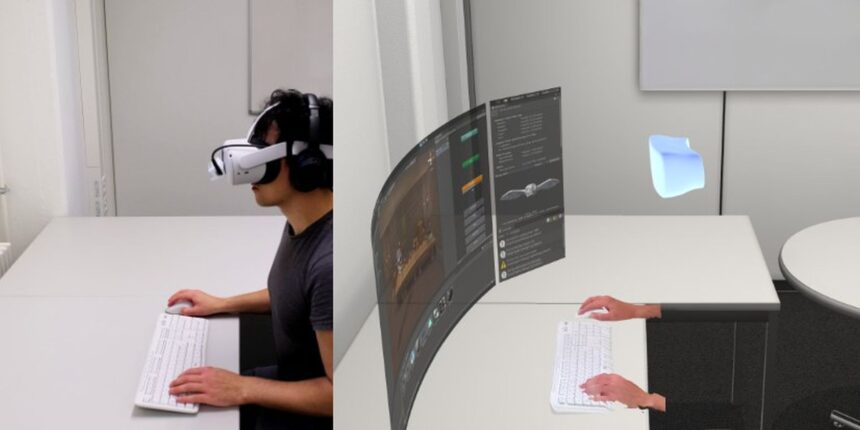Asynchronous Reality: Swiss Researchers “Freeze” Time in Virtual Reality
Two researchers in Switzerland have managed to manipulate time in a virtual reality workplace. The experiment was aimed at promoting greater concentration inside a VR workplace and the researchers used VR headsets to hide interruptions in reality and record these for later viewing.

The scientists at ETH Zurich presented the concept as an “asynchronous reality”. The experiment stops time inside an immersive environment to enable the participant to concentrate on their work. As a result, the events happening in real life that are missed when the participant is engrossed in their work are recouped inside virtual reality. The ‘missed’ reality is captured and presented inside VR, allowing the VR-based worker to catch up with the happenings in the real world.
The Time Manipulation Could Result in Greater Concentration Inside VR
Mark Zuckerberg is envisioning a future where virtual reality headsets, augmented reality headsets, immersive peripherals, and metaverses will dominate our world and, indeed, our work life. The future workplace will be a virtual workplace where users might not even need a physical keyboard or physical phone. Meta’s upcoming high-end Cambria headsets illustrate how this extended reality might end up replacing physical laptops in the future. Such a metaverse will also free Meta from over-reliance on the hardware and software ecosystems created by competitors like Google and Apple.
The research team at ETH Zurich is equally dedicated to building the immersive offices of the future and is currently building a unique tool that illustrates the infinite possibilities of a future XR workplace. Its Asynchronous Reality aims to promote immersive work in VR environments. It should come in handy in the so-called “Focus Mode” which supports the time in the virtual workplace.
In the Focus Mode in “Asynchronous Reality”, the interactions from the real world or your work colleagues are hidden from you via an AR interface. Only after deactivating the Focus Mode does time continue running normally and the events that happened while you were in the Focus Mode begin to play out in your virtual workspace.
To create the Asynchronous Reality, the system reconstructs the volumetric scenes with real-time 3D depth cameras. The researchers say the system should be able to recognize casual dependencies of actions and play back the situations selectively based on user perception.
Asynchronous Reality in Everyday Work
The researchers presented a 9-minute video showing what everyday work would look like in an Asynchronous Reality. The video shows a programmer working with a colleague in an immersive work environment on a virtual reality game and a 3D design of an action figure being created from it. The office is equipped with cameras and the people and objects in the space are streamed into the virtual environment through real-time 3D scans. Once the meetings occur in reality and in a shared virtual work environment, the programmer switches on the Focus Mode.
To hide distractions, the Virtual Reality headset produces some sound and the system only shows scanned objects in the immediate vicinity like the desk, mouse, or keyboard.
Past Events are Replayed as Holograms
When a colleague comes in through the door, their image is captured and scanned via the cameras but they are momentarily hidden from the programmer. The system will save the whole processes and changes in the room such as new objects in the room. The new objects are initially rendered only as glittering outlines. The programmer will only notice them when they consciously turn around and they don’t get a notification either.
If the programmer sees a new object introduced in the room by a colleague and wants to examine it, they can tap it in VR. The system will, subsequently, play back the pre-recorded events in the form of a brief hologram. They can see the hologram of a colleague bringing an object into the room, placing it on the table and they can even hear what the colleague is saying to them.
The Asynchronous Reality Recognizes Causal Relationships
If there are several events happening in the room during the Focus Mode that alter the previous events, such as the adding or removing of new objects, the system will recognize the causal relationships and create a timeline that automatically marks the related events.
For instance, if the busy programmer first plays back an event that happened last after the Focus Mode ended, the system will first show them the events necessary to make sense of the whole process. For additional details on the Asynchronous Reality Office along with more examples of its implementation, check out the research paper by the team.
https://virtualrealitytimes.com/2022/05/02/asynchronous-reality-swiss-researchers-freeze-time-in-virtual-reality/https://virtualrealitytimes.com/wp-content/uploads/2022/05/Asynchronous-Reality-600x300.jpghttps://virtualrealitytimes.com/wp-content/uploads/2022/05/Asynchronous-Reality-150x90.jpgTechnologyTwo researchers in Switzerland have managed to manipulate time in a virtual reality workplace. The experiment was aimed at promoting greater concentration inside a VR workplace and the researchers used VR headsets to hide interruptions in reality and record these for later viewing. The scientists at ETH Zurich presented the...Sam OchanjiSam Ochanji[email protected]SubscriberVirtual Reality Times - Metaverse & VR
